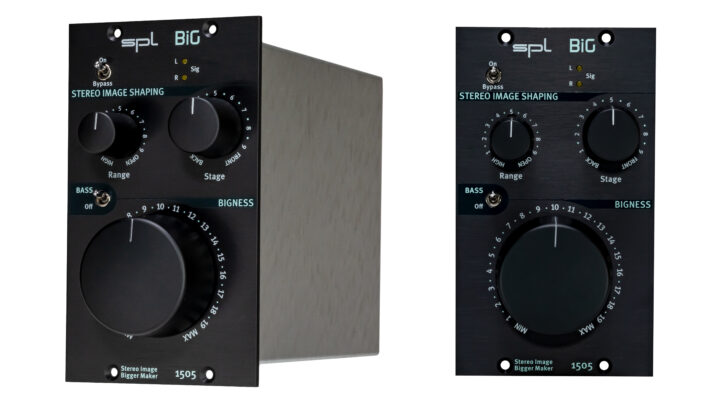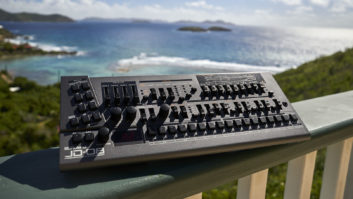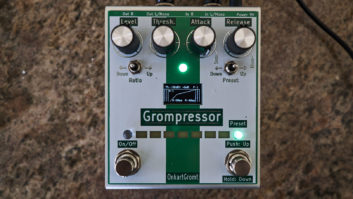
| MIX VERDICT: SPL BiG Stereo Stage Processor |
| THE TAKEAWAY: “Carefully used, like any powerful processor, it can work wonders on non-correlated stereo audio and is magical!” |
| COMPANY: SPL • spl.audio PRICE: $649 PROS: • Very exacting stereo widening processor with specific parameters. CONS: • Takes time and some care when listening and adjusting. |
SPL’s BiG is a dual-slot, 500 series stereo analog module that manipulates the stereo sound image, or stage. When used judiciously, the stereo width, presence and depth can be altered while maintaining accuracy and overall mix balance.
BiG, which is distributed by Focal-Naim America/Canada, works on the components of stereo audio that have little or no correlation between the left and right channels. Stereo L/R audio coming into BiG is algebraically summed [S=(L-R)] to produce a full-spectrum signal that contains only non-correlated information and phase anomalies, such as those generated by added reverb, room acoustics, multiple microphones and delays. This signal is fed into a highly modified, state-variable filter. A typical state-variable filter is capable of producing lowpass, highpass and bandpass outputs all at the same time, and all from a single audio input.
At the top of BiG’s front panel are the interactive Range and Stage controls, specifically designed controlling parameters for adjusting BiG’s state-variable filter. Range is the filter’s frequency control, with an operating range from 6 kHz, at full counter-clockwise (High), to 500 Hz at full clockwise (Open).
SPL of Germany MTC MK2 Monitor Controller Debuts
The larger Stage knob controls the filter’s bandwidth and slope. When the Stage control is fully CCW in the Back position, the center frequency of the Range control is 1.5 kHz. As Stage is turned clockwise, the Range frequency goes lower and lower—until about 110 Hz. Because of the filter’s design, the amount of phase shift and slope is identical in all positions.
With the Range control at High, turning the Stage control from “Back” to “Front” at full clockwise, the slope of the filter becomes increasingly steeper, with a concomitant phase shift. The sonic result is that stereo-panned instruments and voices become closer and louder to the “front of the stage” for the listener. As the Stage control reached the Front position, my auditory perception was that the stereo sound seemed to wrap around me.
The third control on SPL’s front panel is the large Bigness control knob that blends this processed audio back into the stereo output using a proprietary combining method.
The final section is a master EQ—a passive bell-shape equalizer for a 2 dB boost at 45 Hz and a 1.5 dB boost at 15 kHz. This EQ is based on the AirBass section of the SPL Iron Mastering Compressor.
MIXING WITH BIG
I found that BiG works most impressively on recordings that already have substantial, non-correlated acoustical ambiance recorded into them. Although any stereo audio can benefit greatly from BiG’s effect, mixes with many panned mono tracks, “stereo” synthesizers, and contrived L/R delays may not benefit as much.
I had a recording of Manhattan Transfer’s 50 album that has a cover of the Beach Boys’ song “God Only Knows.” This is a live orchestral and choir recording in a live hall using multiple microphones—there are no drums or percussion.
I loaded a copy of the stereo mix into Pro Tools with BiG inserted on the master bus. Listening on both my monitor speakers and headphones, I put a stereo instance of Nugen Audio’s Halo Vision plug-in on the master stereo bus/monitor to visually monitor phase and stereo correlation.
I kept the AirBass EQ on all the time and soon found that there is no wrong or bad way to set BiG except for maybe using way too much of its effect! Generally, the Bigness control only has to be about midway between off and straight up at 12 noon (“10” on the panel) to hear massive changes in the stereo imaging. Furthermore, you can expect a slight overall level increase through the unit with most settings.
DPA 4055 Kick Drum Mic – A Real-World Review
With the Stage control midway (5) in its range and the Range control at 2, I could use plenty of the Bigness control up to the point where the high frequencies started to get shrill at certain moments.
I found that juggling the Range and Bigness controls to dial in just the right balance worked great. I did check the Correlation Matrix window in Halo Vision and saw certain sections of the song were more non-correlated than others, but usually I could get a wide sound and still average way above -0.50, or the anti-correlation threshold where full mono capability is uncertain. This was a recording without the “centering and anchoring effect” of a kick drum or bass instrument.
Keeping the same Range and Bigness settings, rotating the Stage control toward the Front becomes a trade-off between excessive anti-correlation readings and actually altering the mix itself. This led me to try using BiG on individual stereo tracks in a mix.
SEPARATE TRACKS
I tried BiG on a stereo-synthesized harp pluck track that had lots of delay repeats and a little reverb. I kept the Bigness control at 6 or about one-third up, Range at just 2, and Stage at 2, or all the way back counter-clockwise. BiG has a way of making the harp sound overall brighter, panoramically wider and, if the Stage control is turned toward the Front, more immersive—all at the same time.
Listening in mono had close to the same sound as in stereo but lacked some of the low frequencies. In stereo—for this mix—this worked out well on the harp part; it now had a much wider presentation way on the “back wall,” behind the mix.
Next, I tried BiG on the reverb returns of LiquidSonics’ Cinematic Rooms. I liked what BiG did to the reverb sound, and by adjusting Range, Stage and Bigness, I was able to have a reverb wider than the other reverbs in the mix. By nature, reverberation is non-correlated anyway.
On an entire drum kit stem, I had Range at 3, Stage full counter-clockwise (Back), and Bigness at 2. My stereo room tracks came up considerably within the drum mix, and any reverb I had already added to the drums became more present! I also tried BiG directly on the drum overhead tracks without luck. For the drum tracks, I tried it on, the jury is still out.
The SPL BiG provides a good way to expand the stereo imaging of entire mixed tracks, individual stereo instrument and vocal tracks, or stems. Carefully used, like any powerful processor, it can work wonders on non-correlated stereo audio and is magical! Highly recommended. I love it!







